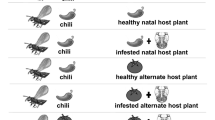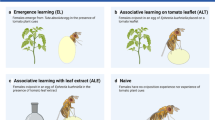Abstract
There is increasing evidence that parasitoid responses to semiochemicals, important stimuli in the host location process, are influenced by experience. This paper focuses on the role of learning, in particular associative learning, in responses to odors. Emphasis is placed on associative learning during the adult stage, the influence of preadult experience is discussed briefly. New data on learning in the speciesLeptopilina heterotoma are given. It is demonstrated that females can learn to respond to a novel odor, which they subsequently use in microhabitat selection. Learning was shown to be associative whereby host products (contact kairomone) or an oviposition experience could function as the reinforcers (reward). The effect of learning seemed stronger when parasitoids were rewarded with an oviposition experience. The paper concludes with a discussion on the application of parasitoid learning in pest management.
Similar content being viewed by others
References
Arthur, A.P. 1966. Associative learning inItoplectis conquisitor (Say) (Hymenoptera: Ichneumonidae).Can. Entomol. 98:213–223.
Arthur, A.P. 1971. Associative learning byNemeritis canescens (Hymenoptera: Ichneumonidae).Can. Entomol. 103:1137–1141.
Carew, T.J., Abrams, T.W., Hawkins, R.D., andKandel, E.R. 1984. The use of simple invertebrate systems to explore psychological issues related to associative learning, pp. 169–184,in D.L. Alton, and J. Farley, (eds.). Primary Neural Substrates of Learning and Behavioral Change. Cambridge University Press, Cambridge.
Corbet, S.A. 1985. Insect chemosensory responses: a chemical legacy hypothesis.Ecol. Entomol. 10:143–153.
Cornell, H.V., andPimentel, D. 1978. Switching in the parasitoidNasonia vitripennis, and its effect on host competition.Ecology 59:297–308.
Dicke, M., vanLenteren, J.C., Boskamp, G.J.F., and vanVoorst, R. 1985. Intensification and prolongation of host searching inLeptopilina heterotoma (Thomson) (Hymenoptera: Eucoilidae) through a kairomone produced byDrosophila melanogaster.J. Chem. Ecol. 11:125–136.
Ding, D., Swedenborg, P.D., andJones, R. 1989. Plant odor preferences and learning inMacrocentrus grandii (Hymenoptera: Braconidae), a larval parasitoid of the European Corn Borer,Ostrinia nubilalis (Lepidoptera: Pyralidae).J. Kansas Entomol. Soc. 62:164–176.
Drost, Y.C., Lewis, W.J., andTumlinson, J.H. 1988. Beneficial arthropod behavior mediated by airborne semiochemicals. V. Influence of rearing method, host plant and adult experience on host-searching behavior ofMicroplitis croceipes (Cresson), a larval parasitoid ofHeliothis.J. Chem. Ecol. 14:1607–1616.
Drost, Y.C., Lewis, W.J., Zanen, P.O., andKeller, M.A. 1986. Beneficial arthropod behavior mediated by airborne semiochemicals. I. Flight behavior and influence of preflight handling ofMicroplitis croceipes (Cresson).J. Chem. Ecol. 12:1247–1262.
Gould, J.L., andMarler, P. 1984. Ethology and the natural history of learning, pp. 47–74,in P. Marler and H.S. Terrace (eds.). The Biology of Learning. Springer-Verlag, New York.
Gross, H.R. 1981. Employment of kairomones in the management of parasitoids, pp. 137–150, in D.A. Nordlund, R.L. Jones, and W.J. Lewis (eds.). Semiochemicals, Their Role in Pest Control. Wiley, New York.
Gross, H.R., Lewis, W.J., Jones, R.L., andNordlund, D.A. 1975. Kairomones and their use for the management of entomophagous insects. III. Stimulation ofTrichogramma achaeae, T. pretiosum andMicroplitis croceipes with hostseeking stimuli at the time of release to improve their efficiency.J. Chem. Ecol. 1:431:438.
Hérard, F., Keller, M.A., Lewis, W.J., andTumlinson, J.H. 1988. Beneficial arthropod behavior mediated by airborne semiochemicals. IV. Influence of host diet on host-oriented flight chamber responses ofMicroplitis demolitor Wilkinson.J. Chem. Ecol. 14:1597–1606.
Jaenike, J. 1983. Induction of host preference inDrosophila melanogaster.Oecologia 58:320–325.
Janssen, A., Driessen, G., Haan, M. de, andRoodbol, N. 1988. The impact of parasitoids on natural populations of temporate woodlandDrosophila.Neth. J. Zool. 38:61–73.
Kaiser, L., Pham-Delegue, M.H., Bakchine, E., andMasson, C. 1989. Olfactory responses ofTrichogramma maidis Pint. et Voeg.: Effects of chemical cues and behavioral plasticity.J. Insect Behav. 2:701–712.
Keller, M.A., Lewis, W.J., andStinner, R.E. 1985. Biological and practical significance of movement byTrichogramma species: A review.Southw. Entomol. Suppl. 8:138–155.
Lewis, W.J. andMartin, W.R. 1990. Semiochemicals for use in biological control: status and future.J. Chem. Ecol. 16:000–000.
Lewis, W.J., andTumlinson, J.H. 1988. Host detection by chemically mediated associative learning in a parasitic wasp.Nature 331:257–259.
Lewis, W.J.,Vet, L.E.M.,Tumlinson, J.H.,van Lenteren, J.C., andPapaj, D.R. 1990. Variation in parasitoid foraging behavior: Essential element of a sound biological control theory.Environ. Entomol. In press.
Loke, W.H. andAshley, T.R. 1984. Potential use of kairomones for behavioral manipulation ofCotesia marginiventris (Cresson).J. Chem. Ecol. 10:1377–1384.
Luck, R.F., andUygun, N. 1986. Host recognition and selection byAphytis species: Response to California red, oleander, and cactus scale cover extracts.Entomol. Exp. Appl. 40:129–136.
Monteith, L.G. 1963. Habituation and associative learning inDrino bohemica Mesn (Dipt.: Tachinidae).Can. Entomol. 95:418–426.
Noldus, L.PJ.J. 1989. Semiochemicals, foraging behavior and quality of entomophagous insects for biological control.J. Appl. Entomol. 108:425–451.
Papaj, D.R., andProkopy, R.J. 1989. Ecological and evolutionary aspects of learning in phytophagous insects.Annu. Rev. Entomol. 34:315–350.
Papaj, D.R., andRausher, M.D. 1983. Individual variation in host location by phytophagous insects, pp. 77–124,in S. Ahmad (ed.). Herbivorous Insects: Host-Seeking Behavior and Mechanisms, Academic Press, New York.
Papaj, D.R., andVet, L.E.M. 1990. Odor learning and foraging success in the parasitoidLeptopilina heterotoma.J. Chem. Ecol. 16:3137 -3150.
Ridgway, R.L.,Ables, J.R.,Goodpasture, C., andHartstack, A.W. 1981.Trichogramma and its utilization for crop protection in the U.S.A. Proceedings, Joint American-Soviet Conference, Use of Beneficial organisms in the control of crop pests. Washington, D.C. pp. 41–48.
Sandlan, K. 1980. Host location byCoccygomimus turionellae (Hymenoptera: Ichneumonidae).Entomol. Exp. Appl. 27:233–245.
Sheehan, W., andShelton, A.M. 1989. The role of experience in plant foraging by the aphid parsitoidDiaretiella rapae (Hymenoptera: Aphidiidae).J. Insect Behav. 2:743–759.
Smith, M.A., andCornell, H.V. 1978. Hopkins host-selection inNasonia vitripennis and its implications for sympatric speciation.Anim. Behav. 27:365–370.
Thorpe, W.H., andJones, F.G.W. 1937. Olfactory conditioning in a parasitic insect and its relation to the problem of host selection.Proc. R. Soc. Ser. B 124:56–81.
Turlings, T.C.J., Tumlinson, J.H., Lewis, W.J., andVet, L.E.M. 1989. Beneficial arthropod behavior mediated by airborne Semiochemicals. VIII. Learning of host-related odors induced by a brief contact experience with host by-products inCotesia marginiventris (Cresson), a generalist larval parasitoid.J. Insect Behav. 2:217–225.
Turlings, T.C.J., Scheepmaker, J.W.A., Vet, L.E.M., Tumlinson, J.H., andLewis, W.J. 1990. How contact foraging experiences affect the preferences for host-related odors in the larval parasitoidCotesia marginiventris (Cresson) (Hymenoptera: Braconidae).J. Chem. Ecol. 16:1577–1589.
Vet, L.E.M. 1983. Host-habitat location through olfactory cues byLeptopilina clavipes (Hartig) (Hym.: Eucoilidae), a parasitoid of fungivorousDrosophila: The influence of conditioning.Neth. J. Zool. 33:225–248.
Vet, L.E.M. 1985a. Olfactory microhabitat location in some eucoilid and alysiine species (Hymenoptera). larval parasitoids ofDiptera.Neth. J. Zool. 35:720–730.
Vet, L.E.M. 1985b. Response to kairomones by some alysiine and eucoilid parasitoid species (Hymenoptera).Neth. J. Zool. 35:486–496.
Vet, L.E.M. 1988. The influence of learning on habitat location and acceptance by parasitoids.Colloq. INRA 48:29–34.
Vet, L.E.M., and vanAlphen, J.J.M. 1985. A comparative functional approach to the host detection behaviour of parasitic wasps. I. A qualitative study on Eucoilidae and Alysiinae.Oikos 44:478–486.
Vet, L.E.M., and vanOpzeeland, K. 1984. The influence of conditioning on olfactory microhabitat and host location inAsobara tabida (Nees) andA. rufescens (Foerster) (Braconidae: Alysiinae), larva parasitoids of Drosophilidae.Oecologia 63:171–177.
Vet, L.E.M., and vanOpzeeland, K. 1985. Olfactory microhabitat selection inLeptopilina heterotoma (Thomson) (Hym.: Eucoilidae), a parasitoid of Drosophilidae.Neth. J. Zool. 35:497–504.
Vet, L.E.M., andSchoonman, G. 1988. The influence of previous foraging experience on microhabitat acceptance inLeptopilina heterotoma.J. Insect Behav. 1:387–392.
Vet, L.E.M., vanLenteren, J.C., Heymans, M., andMeelis, E. 1983. An airflow olfactometer for measuring olfactory responses of hymenopterous parasitoids and other small insects.Physiol Entomol. 8:97–106.
Vet, L.E.M., De Jong, R., van Giessen, W.A. andVisser, J.H. 1990a. A learning-related variation in electroantennogram responses of a parasitic wasp.Physiol. Entomol. 15:243–247.
Vet, L.E.M.,Lewis, W.J.,Papaj, D.R., andvan Lenteren, J.C. 1990b. A variable-response model for parasitoid foraging behavior.J. Insect Behav. 3(4) (in press).
Vinson, S.B., Barfield, C.S., andHenson, R.D. 1977. Oviposition behavior ofBracon mellitor, a parasitoid of the boll weevil (Anthonomus grandis). II. Associative learning.Physiol. Entomol. 2:157–164.
van Alphen, J.J.M., andGalis, F. 1983. Patch time allocation and parasitization efficiency ofAsobara tabida, a larval parasitoid ofDrosophila.J. Anim. Ecol. 52:937–952.
van Alphen, J.J.M., andVet, L.E.M. 1986. An evolutionary approach to host finding and selection, pp. 23–61,in J.K. Waage and D.J. Greathead (eds.). Insect Parasitoids. Academic Press, London.
Wardle, A.R., andBorden, J.H. 1985. Age-dependent associative learning byExeristes roborator (F.) (Hymenoptera: Ichneumonidae).Can. Entomol. 117:605–616.
Wardle, A.R., andBorden, J.H. 1986. Detrimental effect of prior conditioning on host habitat location byExeristes roborator.Naturwissenschaften 73:559–560.
Williams, A.A., Hollands, T.A., andTucknott, O.G. 1981. The gas chromatographic-mass spectrometric examination of the volatiles produced by the fermentation of a sucrose solution.Z. Lebensm. Unters. Forsch. 172:377–381.
Author information
Authors and Affiliations
Rights and permissions
About this article
Cite this article
Vet, L.E.M., Groenewold, A.W. Semiochemicals and learning in parasitoids. J Chem Ecol 16, 3119–3135 (1990). https://doi.org/10.1007/BF00979615
Received:
Accepted:
Issue Date:
DOI: https://doi.org/10.1007/BF00979615




